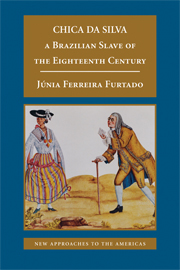Book contents
- Frontmatter
- Contents
- Acknowledgments
- Preface
- Maps
- Introduction to the English Edition
- 1 Land of Stars
- 2 Chica da Silva
- 3 The Diamond Contractors
- 4 Black Diamond
- 5 The Lady of Tejuco
- 6 Life in the Village
- 7 Mines of Splendor
- 8 Separation
- 9 Disputes
- 10 Destinies
- 11 Chica-que-manda
- Abbreviations
- Suggested Reading
- Index
- Plate section
Preface
Published online by Cambridge University Press: 05 September 2014
- Frontmatter
- Contents
- Acknowledgments
- Preface
- Maps
- Introduction to the English Edition
- 1 Land of Stars
- 2 Chica da Silva
- 3 The Diamond Contractors
- 4 Black Diamond
- 5 The Lady of Tejuco
- 6 Life in the Village
- 7 Mines of Splendor
- 8 Separation
- 9 Disputes
- 10 Destinies
- 11 Chica-que-manda
- Abbreviations
- Suggested Reading
- Index
- Plate section
Summary
The day is still to come
When they shall turn to us and ask:
Who was this Chica da Silva,
That once lived in this place?
Sometime around the second quarter of the twentieth century, the journalist Antônio Torres gathered together items he found in various notebooks on figures and events from the history of Tejuco, then known by the name of Diamantina. On Chica da Silva he wrote: “It is said that her corpse was found many years after her death and that her skin was still dry and black.” At first glance, this affirmation might seem to suggest sainthood; after all, Chica would not have been the first or the last in the long line of Luso-Brazilian tradition to have been found in such a state, considered a triumph over deathly decay and a testament to the saintliness and purity of the deceased. An example of this phenomenon occurred in 1752, when the Portuguese newspaper Gazeta de Lisboa announced the death of Sister Isabel de Madre de Deus, a native of Bahia, attributing the fact that her body remained flexible and the presence of sweat in her coffin to the virtuous life she had led, “having lived abstracted from worldly things, conserving her memory and diligence for no other purpose than to serve God.”
Chica da Silva was buried in the church of São Francisco de Assis in Tejuco, whose stone portal bore the carved image of Saint Margarida of Cortona.
- Type
- Chapter
- Information
- Chica da SilvaA Brazilian Slave of the Eighteenth Century, pp. xvii - xxvPublisher: Cambridge University PressPrint publication year: 2008

